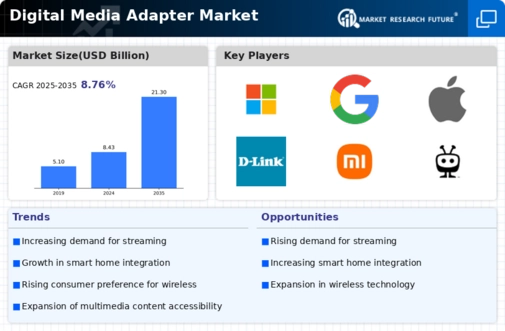The Digital Media Adapter Market is characterized by a dynamic competitive landscape driven by the rapid evolution of technology and consumer preferences. The market comprises a diverse range of players, each contributing unique capabilities and innovations that enhance the functionality and connectivity of digital media devices. Companies are constantly striving to capture market share by offering compelling features, robust user experiences, and improved compatibility across a multitude of platforms. With the increasing demand for seamless content streaming and the proliferation of smart home devices, competition has intensified, encouraging both established brands and new entrants to innovate and differentiate their offerings.
Trends such as the integration of voice control, support for high-resolution content, and a focus on user-friendly interfaces are at the forefront of market competition, prompting companies to adapt swiftly to evolving consumer needs.
Microsoft's presence in the Digital Media Adapter Market showcases its strengths in software integration, advanced technology solutions, and brand loyalty. The company has effectively leveraged its expertise in cloud services and software development to deliver digital media adapters that ensure smooth connectivity with its ecosystem of products. By fostering partnerships with content providers and hardware manufacturers, Microsoft has created a cohesive environment that enhances user experiences. The company's commitment to integrating its digital media adapters with platforms such as Xbox and Windows has positioned it favorably within the market, allowing for seamless streaming and enhanced gaming experiences.
Moreover, Microsoft's emphasis on security features contributes to consumer trust, reinforcing its competitive edge as users seek reliable and protected streaming solutions.
Google has also carved a significant niche within the Digital Media Adapter Market, underpinning its offerings with superior technology and a commitment to innovation. Known for its user-centric design philosophy, Google focuses on delivering digital media adapters that facilitate easy access to an extensive library of content across various streaming platforms. The Chromecast line, for instance, exemplifies Google's ability to integrate software and hardware to create a unified user experience that is intuitive and versatile.
Additionally, by incorporating Google Assistant and compatibility with smart home ecosystems, Google has strengthened the functionality of its devices, allowing for voice-activated commands and seamless device interoperability. This commitment to enhancing the digital media experience, along with robust marketing strategies, has positioned Google as a formidable player in the competitive landscape of the digital media adapter market.






















